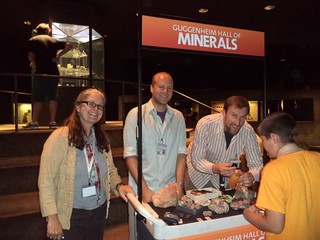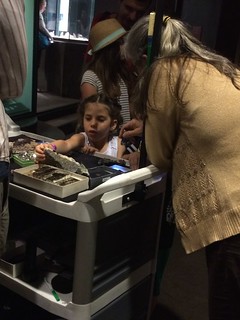Kids in the Hall? No, Carts in the Hall
We finished up our first segment of curriculum and pedagogical chunk of our MAT program…working on carts in the halls. Carts are an assemblage of artifacts or rock samples or minerals from a hall that are setup for interacting with museum visitors. It’s a “please touch” station. We, as MAT students, worked in groups of three on a cart for four hours at a stretch in one of these halls: Gems & Minerals, Mexico & Central America, New York State Environments, African Peoples, and Planet Earth. We did this on seven different days.

This was our first dip into teaching with a museum collection or using informal teaching. We were shown how to use inquiry-based discussion with the visitors…’what do you think it is?...how do you think they would use this?...do you think you might have this in your home?’ so that it was setup as a discussion rather then a one-way stream of us, cart people, feeding answers to them, the museum patrons. This inquiry-based style of teaching reminds me of when I worked at a summer camp the past three summers. Camp kids come in knowing a lot already, you guide them, using their brains, to new places to understand new concepts. It was like that on the carts. But with folks from 3 years old to over seventy. And just like camp, these visitors are there because they want to be. The visitors can leave your cart at any moment or not even come over to your cart. It’s a free choice situation.
One of the great things about this program at this museum is that, because AMNH is a world-renowned natural history museum, people come to visit it from all over the world. On the carts, we got so many vacationers/visitors from everywhere and it challenges a person to try to convey knowledge when there is no common language. This, too, is practice for our school residency and our futures as teachers. A large percentage of students in NYC are not English-language learners.
Carts were fun. Next informal learning session will be with a group teens who are in a summer enrichment program. I do not know exactly what we will be doing with those young people, but I will report back. So far I know we are engaged with a lot of team-teaching experiences. I haven’t had to fly solo yet and I really appreciate that.
So, on to the Learning Management System. I am working towards a teaching credential to teach earth science in the New York state public school system. Our first class in the MAT program has been mostly on-line with a small chunk of face-to-face time. I am not opposed to on-line education but I can pretty much guarantee that I will not be doing any on-line teaching with my students so it’s weird. The LMS is the Moodle platform and, though this installation of Moodle is better than the one I had to use at Bard last semester, it is still a closed system. We’re all doing and saying some interesting things but only the 15 of us plus the 2 (or is it three?) instructors get to see it. I am not a fan of Moodle or the LMS environment and only know from being on the teaching end is that it makes classroom management much easier to ask students to upload their document by X time and date, they get an email confirmation, teacher knows they uploaded it and at what time (is it late?), teacher can see how many posts the student did to the forum, and then teacher can do the grades in Moodle. Ugh. It is pretty clunky. Classroom Management and Learning Management make me cringe.
But the class, even though I’m nagging about it being on-line, has been pretty interesting. I’ve had to be self-directed, but the way the course is set-up, we all can follow paths that we are interested in taking, topics we wish to investigate and write about. Plus some of the assignments have involved visuals like creating graphics and use of Google Maps. The face-to-face aspect of the course is preparation for how we will teach this topic in our future Earth Science classroom.
First month down, 14 more to go!










